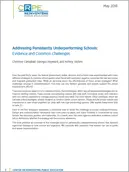This brief provides an overview of five strategies education leaders use with continually underperforming schools. Categorized as turnaround strategies or new school strategies, each represents a distinctive approach to school improvement and varies in design and implementation from place to place.
Turnaround Strategies
With the aim of improving underperforming schools through new governance and staffing arrangements, turnaround strategies include school reconstitution, innovation zones, and charter conversion. The strategies’ common challenges, notable examples, and evidence on outcomes are described.
New School Strategies
Designed to help students attend better schools, new school strategies include school closure and intentional development of new school pipelines through requests for proposals (RFPs). Some of the challenges, examples, and outcomes are outlined.
Questions to Ask When Choosing or Assessing an Improvement Strategy
Each strategy represents a distinctive approach to improving underperforming schools and requires leaders to address five questions:
- Do schools have the staff they need?
- What role can charter operators play?
- Can you build support and survive opposition?
- Can education leaders monitor the success of the strategy?
- Are long-term financial resources available?






